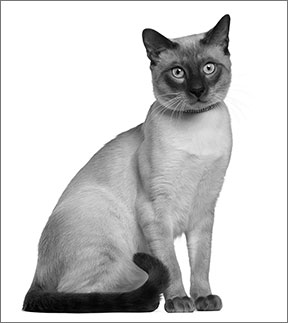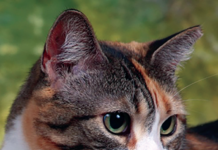If your cat’s coat changes color, don’t become alarmed. In many cases, it’s could be a normal development. The hair of some cats, particularly those who are dark, turns gray as they age. Siamese kittens begin life with light-colored coats, without the characteristic dark “points” they will develop later on the nose, ears, tail and paws.

288
However, a number of medical conditions can also cause a cat’s hair color to change, says dermatologist William H. Miller, VMD, Medical Director of the Cornell University Companion Animal Hospital. These conditions range from skin disorders, such as flea allergies and mange, to hormonal deficiencies such as hypothyroidism, to serious illnesses, including cancer.
Abnormal Pigment. “Diseases can impact the quality, texture and color of the hair,” Dr. Miller says. “Endocrine disease, especially hypothyroidism, and the disorders associated with abnormal sex hormone production can alter hair color either because the hair isn’t growing as fast and is subject to sun bleaching — or because the mechanism whereby the pigment is transferred to the growing hair is abnormal.”
If the skin or coat has a color other than white — including brown, black, red and yellow — it’s said to be pigmented. If the skin is darker than normal, it is said to be hyper-pigmented. Some conditions associated with pigment change may be more common in certain geographical areas.
For example, the temperature of the cat’s environment can affect pigment change. Some coats may become darker in cold winter months while the coats of dark-colored cats can bleach to a reddish-brown color in sunny areas.
“There is a disease called vitiligo where the melanocytes — the pigment cells that produce the dark pigment melanin — disappear and don’t return,” Dr. Miller says. “This depigmentation can be regional or generalized. And while the coat color change by itself doesn’t cause any symptoms, if the hair and underlying skin turn white due to vitiligo, then that area is particularly prone to sunburn.” Vitiligo can be hereditary or caused by an autoimmune reaction.
Breed Disposition. Some breeds are particularly susceptible to hair color change. “Different breeds tend to get certain diseases that may or may not induce depigmentation,” says Dr. Miller. “For instance, Siamese cats have temperature-sensitive melanocytes, so the hairs will lighten or darken depending on the skin temperature. If the exposed area is cold, it becomes lighter-colored. If warmed, it returns to its normal dark color or may even become darker than normal.”
In addition, Dr. Miller says, “If a cat has a high fever, hairs in hot areas may lighten in color. A classic example is ‘goggles’ — whitening of the fur around the eyes when a cat has a fever.”
Because the amino acid tyrosine is needed to make melanin — a natural substance that determines color of the hair and skin — a diet deficient in tyrosine can cause a black cat’s hair color to lighten to a reddish color. Other nutritional problems, such as copper deficiency and zinc excess, can have the same effect. However, Dr. Miller says, “Diet is rarely an issue these days since most cats eat balanced cat food diets.”
Underlying Cause. Although any area can be affected, “Cat owners tend to notice hair color change first on the face, since that’s where we look at our pets most often,” Dr. Miller says. A quick diagnosis may be difficult to make. “While it’s easy to document hair color change with the naked eye, the underlying cause can be determined only by a complete and through history and physical examination,” says Dr. Miller. “This provides the veterinarian with an idea of the disorders that might be causing the color change. Such disorders can then be confirmed by the appropriate diagnostic tests
and addressed.”
Color change doesn’t necessarily require treatment. If the color change is due to a disease other than vitiligo, the prognosis is good. If the disease can be cured, the hair color should return to normal.
If owners notice a hair color change in their cat, it’s a sign that something is amiss. Paying attention to your cat’s coat over time can help you gauge the quality of his health, Dr. Miller says. “Unless the owner can associate the color change with some topical insult to the hair — for example, a benzoyl peroxide shampoo — or unless the color change can be attributed to harmless sun bleaching or old age, hair color change should prompt a visit to the veterinarian.” ❖



